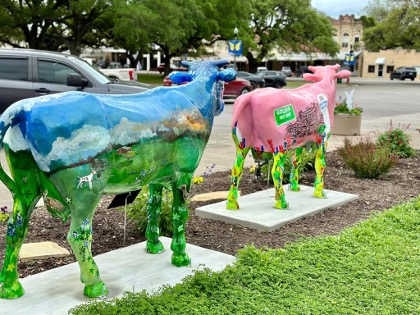Conserving Springfield’s 4,000 acres of green spaces requires creative resourcing and volunteers – KSMU

Report on Local Conservation Initiatives in Springfield-Greene County and Alignment with Sustainable Development Goals
Executive Summary
- An interview with Caleb Saunders, Conservation Coordinator for the Springfield-Greene County Park Board, detailed local programs focused on preserving the ecological integrity of the region’s public green spaces.
- The initiatives directly address several United Nations Sustainable Development Goals (SDGs), particularly those related to sustainable urban environments, biodiversity, and community partnerships.
- The report highlights the critical role of volunteerism as a mechanism for achieving these conservation and sustainability objectives.
Contribution to SDG 11: Sustainable Cities and Communities
- The management and preservation of over 100 parks and green spaces directly support SDG 11, which aims to make cities and human settlements inclusive, safe, resilient, and sustainable.
- These efforts specifically advance Target 11.7, which calls for providing universal access to safe, inclusive, and accessible green and public spaces, enhancing community well-being and urban quality of life.
Contribution to SDG 15: Life on Land
- The core mission to maintain and preserve ecological integrity is a direct implementation of SDG 15, which focuses on protecting, restoring, and promoting the sustainable use of terrestrial ecosystems.
- Key program activities contribute to:
- Halting the degradation of natural habitats within the urban landscape (Target 15.5).
- Conserving local biodiversity.
- Promoting the sustainable management of urban forests and green corridors.
Fostering Partnerships for the Goals (SDG 17)
- The operational model described by Mr. Saunders exemplifies SDG 17, which encourages partnerships for sustainable development.
- Public-Civil Society Partnership: The emphasis on volunteers as a “vital” component showcases an effective partnership between a public institution (the Park Board) and civil society, mobilizing community action to achieve shared environmental goals (Target 17.17).
- Media and Advocacy Partnership: The “Making Democracy Work” program, a collaboration between KSMU Radio and the League of Women Voters, serves as a key platform for raising public awareness and fostering education on sustainability issues, aligning with SDG 4 (Quality Education) and SDG 17.
Call to Action: Community Participation in Achieving the SDGs
- The report underscores that community involvement is essential for the success and scalability of these conservation programs.
- Citizens interested in contributing to local sustainability and the achievement of the SDGs are encouraged to participate. Opportunities for involvement include:
- Engaging in direct conservation activities within the park system.
- Participating in environmental stewardship programs.
- Supporting the collaborative efforts of the Park Board and its community partners.
Analysis of Sustainable Development Goals in the Article
1. Which SDGs are addressed or connected to the issues highlighted in the article?
-
SDG 11: Sustainable Cities and Communities
This goal is relevant because the article focuses on the management of “more than 100 parks and green space” within the city of Springfield. Green public spaces are a key component of sustainable urban development, contributing to the well-being of residents and the environmental health of the city.
-
SDG 15: Life on Land
This goal is directly addressed through the article’s central theme of “maintaining and preserving the ecological integrity” of parks. This involves protecting local ecosystems and biodiversity within the urban environment, which is a core aspect of SDG 15.
-
SDG 17: Partnerships for the Goals
The article highlights that “volunteers are vital” for the conservation efforts of the Springfield-Greene County Park Board. This emphasis on collaboration between a public entity (the Park Board) and civil society (volunteers) connects directly to the principle of forming partnerships to achieve sustainable development objectives.
2. What specific targets under those SDGs can be identified based on the article’s content?
-
Target 11.7: Provide universal access to safe, inclusive and accessible, green and public spaces.
The article’s discussion of maintaining “more than 100 parks and green space” for the community directly relates to this target. The work of the Park Board ensures these spaces remain available and ecologically healthy for public use.
-
Target 15.5: Take urgent and significant action to reduce the degradation of natural habitats and halt the loss of biodiversity.
The role of the conservation coordinator, which involves “maintaining and preserving the ecological integrity,” is a direct action aimed at preventing the degradation of the natural habitats found within the city’s parks.
-
Target 17.17: Encourage and promote effective public, public-private and civil society partnerships.
The article’s statement that “volunteers are vital” and the mention of sharing “how those interested in participating can get involved” is a clear example of a public body actively promoting and relying on partnerships with civil society to achieve its conservation goals.
3. Are there any indicators mentioned or implied in the article that can be used to measure progress towards the identified targets?
-
Implied Indicator for Target 11.7: The number and area of public green spaces.
The article mentions “more than 100 parks and green space” in Springfield. This figure serves as a direct, quantifiable measure of the availability of public green spaces within the city, which is a key component of the official indicator 11.7.1 (average share of the built-up area of cities that is open space for public use).
-
Implied Indicator for Target 15.5: The existence of conservation programs and dedicated staff.
The article’s reference to “vital programs” for preservation and the specific role of a “conservation coordinator” implies a structured effort to protect local ecosystems. The existence and funding of such programs and positions can be used as an indicator of a city’s commitment to halting habitat degradation.
-
Implied Indicator for Target 17.17: The level of volunteer engagement.
The statement that “volunteers are vital” and the active call for participation imply that the number of volunteers, the hours they contribute, and the range of activities they support are used as measures of the success of the civil society partnership. This can be tracked to measure progress towards this target.
4. Summary Table of SDGs, Targets, and Indicators
| SDGs | Targets | Indicators (Mentioned or Implied) |
|---|---|---|
| SDG 11: Sustainable Cities and Communities | 11.7: Provide universal access to safe, inclusive and accessible, green and public spaces. | The existence of “more than 100 parks and green space” in the city. |
| SDG 15: Life on Land | 15.5: Take urgent and significant action to reduce the degradation of natural habitats and halt the loss of biodiversity. | The existence of “vital programs” and a dedicated “conservation coordinator” focused on preserving ecological integrity. |
| SDG 17: Partnerships for the Goals | 17.17: Encourage and promote effective public, public-private and civil society partnerships. | The active recruitment and vital role of volunteers in conservation efforts. |
Source: ksmu.org

What is Your Reaction?
 Like
0
Like
0
 Dislike
0
Dislike
0
 Love
0
Love
0
 Funny
0
Funny
0
 Angry
0
Angry
0
 Sad
0
Sad
0
 Wow
0
Wow
0









































































